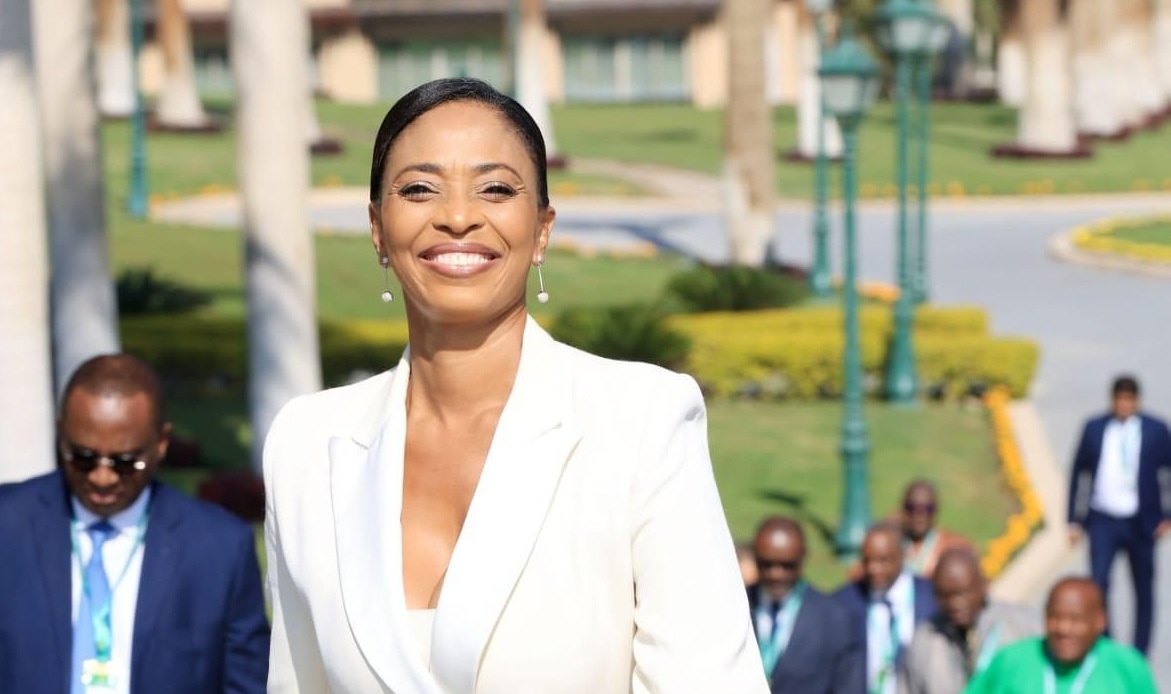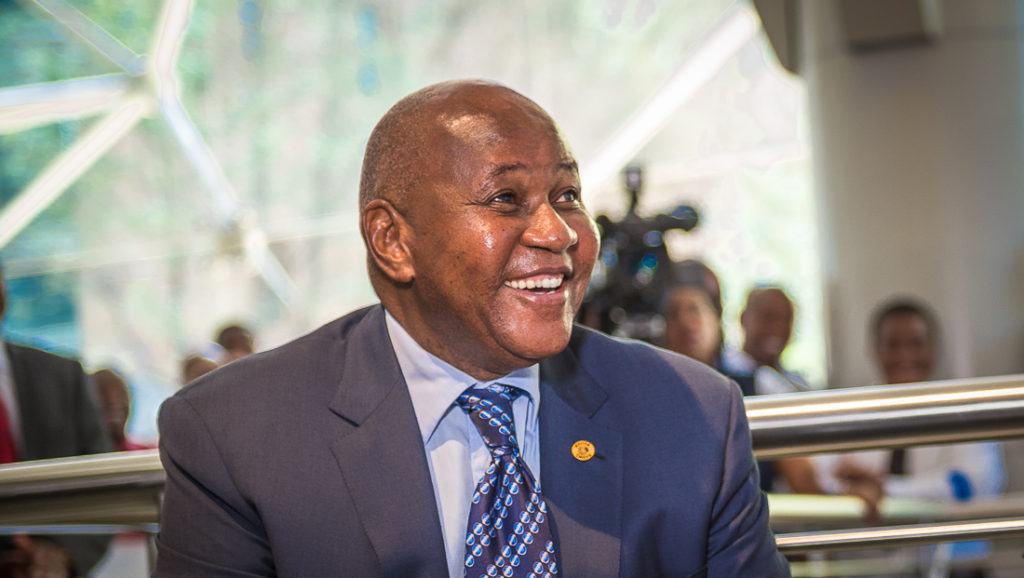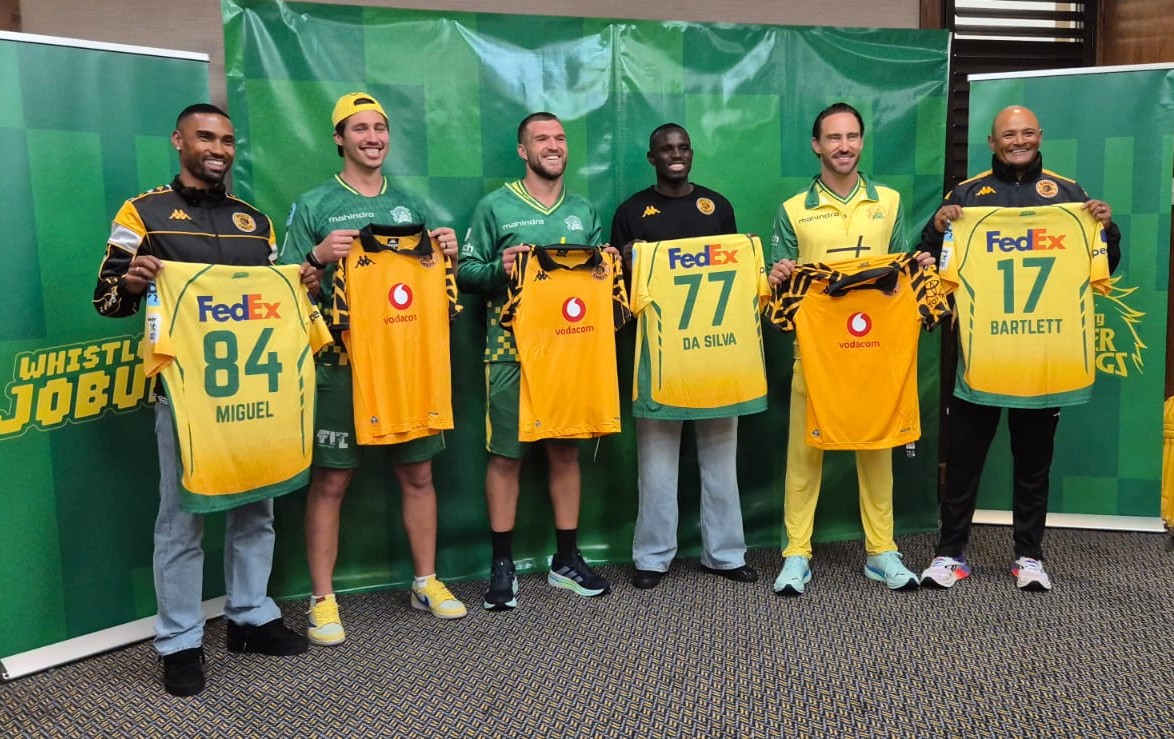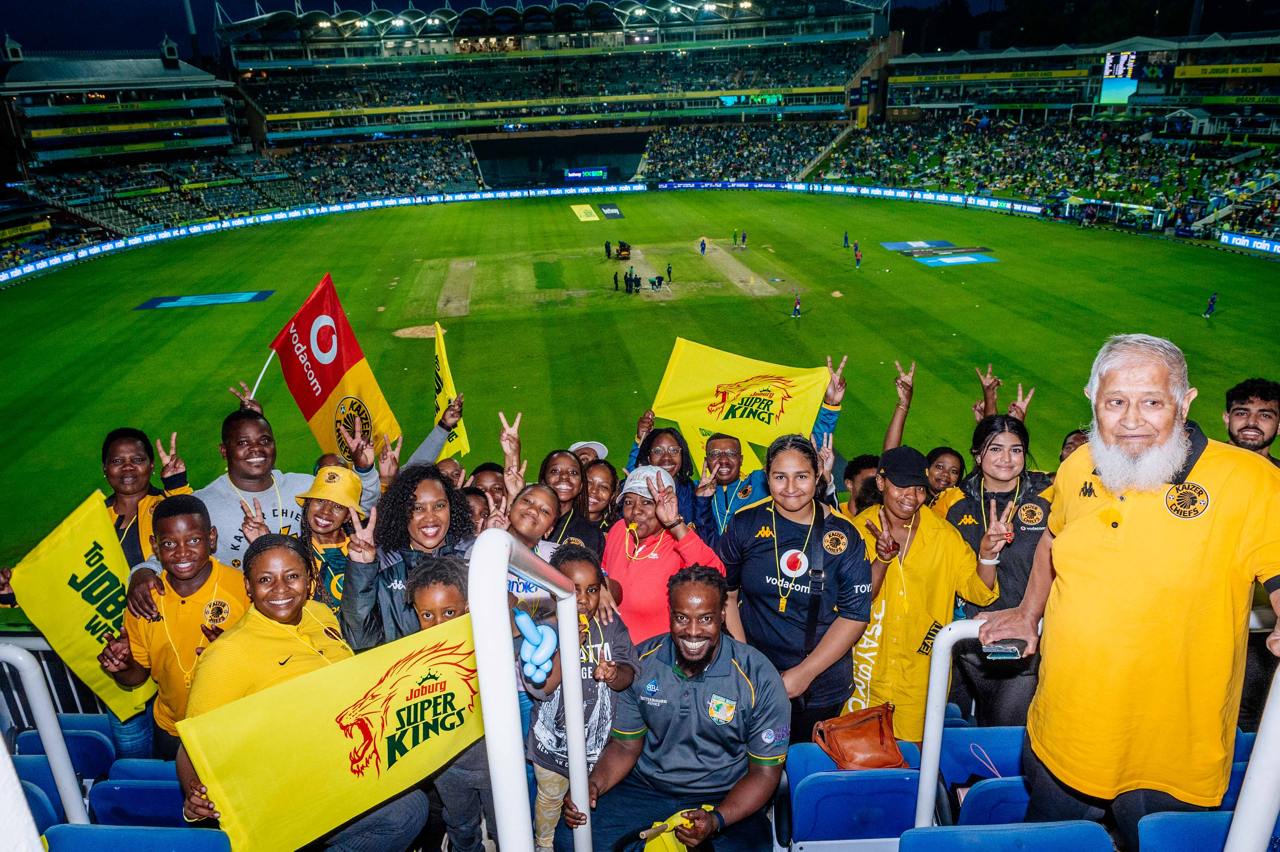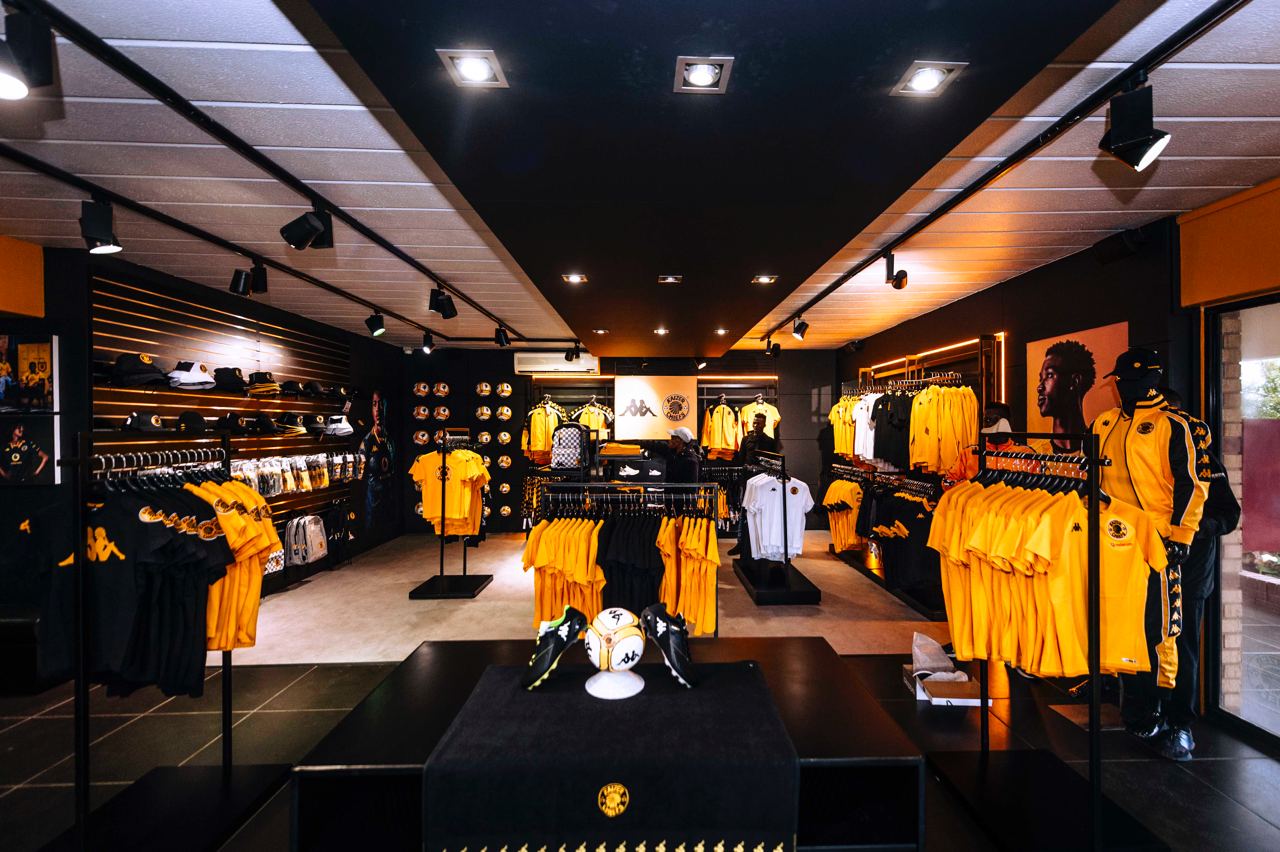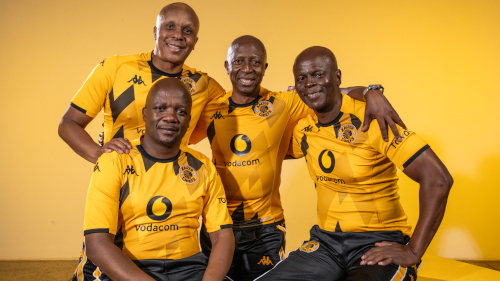Posted in General on Jun 10, 2016.

The 1970's (1970-1979)
The birth of Kaizer Chiefs
The extraordinary story of Kaizer Chiefs is indelibly linked to the life and football career of the man the club derives its name from.
While Kaizer Chiefs may well have been formally formed on 7 January 1970, its story has its origins in the tumultuous 1960s when Kaizer Motaung first forged his name as a teenager at Orlando Pirates before gaining global acclaim in the North American Soccer League with Atlanta Chiefs.
As a teenage prodigy at Orlando Pirates, Motaung made his senior debut for the Buccaneers at the age of just 16, setting the then South African Soccer League alight with his explosive talent.
Motaung was recruited in 1968 by Atlanta Chiefs to play in the inaugural North American Soccer League and made his debut for Atlanta Chiefs on 27 May 1968 against English champions Manchester City as a substitute, scoring on debut as Chiefs won 3-2.
The South African ended the season being voted NASL ‘Rookie of The Year’ and was instrumental in Atlanta Chiefs being crowned champions that year.
The following season, ‘Boy Boy’, as the South African was soon nicknamed in America, scored 16 goals in 16 matches, becoming the top goal scorer in the league as he was voted onto the NASL All-Star Team.
At the height of his powers in the United States, however, Motaung was drawn back to South Africa when there was major mutiny on the Orlando Pirates ship.
In late 1969 Motaung returned home with Pirates suffering major internal problems and with team manager Ewert Nene and three players, Ratha Mokgoatlheng, Msomi Khoza and Zero Johnson, expelled and banished from Pirates and essentially rendered “homeless” in the football sense for various reasons.
Motaung tried his utmost to resolve the impasse, but was unsuccessful. Out of these circumstances, an invitational Kaizer XI was formed in late 1969.
Kaizer XI played numerous friendlies, fielding a fantastic team with players such as Alfred ‘Bomber’ Chamane, Vincent ‘Tantie’ Julius, Ingle Singh, Jackie Masike, Herman ‘Pelé’ Blaschke, Patrick ‘Ace’Ntsoelengoe and the three former Pirates players who were expelled.
As they played far and wide in every corner of the country, there was a huge, fanatical response from supporters to the flowing football and glamour of the Kaizer XI.
And when the time came for Motaung to return to the United States, there was a huge clamour from fans for the invitational team to continue and for it to be formalised.
Motaung volunteered to lead the process of establishing a new club, which was officially established at 8414 Sentsho Street in Phefeni, Orlando West Soweto on 7 January 1970.
Other than the expelled Pirates trio, other great footballers such as Eliakim ‘Pro’ Khumalo and Ariel Kgongoane also considered themselves free agents and joined Kaizer Chiefs, knowing just how much consternation this would cause at Orlando Pirates.
It was far from plain sailing during the new club’s formative years. Many within the football fraternity viewed them as upstarts and did not want them to succeed. Fortunately though, most of the players bought into Motaung’s vision of setting up a club that would be run professionally, and trusted his integrity.
With the support of various business partners to supplement Motaung’s personal capital investment, Kaizer Chiefs soon became a force to be reckoned with, winning their first league title in 1974.
Motaung contributed 13 league goals to the triumph, despite missing most of the season while playing for Denver Dynamos in the NASL.
In addition to the 1974 league title, Kaizer Chiefs won numerous trophies in the early 1970s, including league titles in 1977 and a unified multiracial league title in 1979, the BP Top Eight (1973, 1974, 1976), Champion of Champions (1972, 1974, 1976) and the Life Challenge Cup (1971, 1972).
Fans flocked from all corners to be enthralled by the excitement provided by a team brimming with fantastic players. Joseph ‘Banks’ Sethlodi, an accomplished goalkeeper who also took the penalties, defenders Masike and Ryder Mofokeng, midfielders Petros ‘Ten-Ten’ Nzimande, Patrick ‘Ace’ Ntsoelengoe, Vusi ‘Computer’ Lamola and strikers Pelé Blaschke, Michael ‘Bizzah’ Dlamini and Abednigo ‘Shaka’ Ngcobo were all instrumental in creating the swashbuckling style of flowing, entertaining, winning football that attracted supporters by their millions, and has become synonymous with the Kaizer Chiefs brand.
Of that formidable group of footballing pioneers, Motaung is always first to say that “we as Kaizer Chiefs are standing on the shoulders of that generation. If it wasn’t for the success they had in those early years, I don’t know where we would be today.”
With the team’s success came affectionate nicknames, with Amakhosi (which means ‘chiefs’ or ‘kings’ in Zulu) and the (Phefeni) Glamour Boys being the most prominent.
The latter label was given by the supporters because Motaung always insisted that his players were always immaculately and stylishly dressed to fit in with the professional image of the club.
Those halcyon years were also defined by the Afro hairstyle, which became popular with many players who imitated Motaung’s trendsetting style when he returned from America sporting the new look.
The club’s slogan of ‘Love & Peace’ came about as an expression of non-aggression in response to a growing wave of violence among fans of other clubs, especially when their teams were losing. The mantra was, and still remains, a core element capturing what it means to be a Kaizer Chiefs fan.
After wrapping up his successful career in the United States, Motaung returned home permanently in 1975 to continue playing for and running the club that he had helped establish five years earlier.
However, he hung up his soccer boots only a year later to concentrate fully on guiding Chiefs on their path to becoming the dominant force in South African football that it is today.
Motaung’s decision to focus solely on the administration of the club in 1976 was swayed by the tragic death that year Nene. Chiefs’ popular team manager, who had recruited many of the team’s star players, was in Springs to sign up talented young winger, Nelson ‘Teenage’ Dladla, when he was attacked and murdered by hooligans who did not want to lose their favourite player to the Glamour Boys.
In Nene’s absence, Motaung’s administrative responsibilities increased, leaving him insufficient time to devote to playing.
South Africa’s first multiracial league kicked off in 1978, with Kaizer Chiefs achieving a respectable fourth position at the end of the season, as the highest placed traditionally black side, behind originally white clubs, Lusitano, Wits University and Arcadia Shepherds.
One year on though, Amakosi were champions, holding off strong competition from Highlands Park and Arcadia Shepherds.
By that time, a number of white players had joined Chiefs, the first of which was Lucky Stylianou, a defensive midfielder. Others would soon follow, including goalkeeper Peta Bala’c, Jimmy ‘Brixton Tower’ Joubert and Frank ‘Jingles’ Pereira.
Amakhosi were by now South Africa’s most popular team. The magic of Kaizer Chiefs derives directly from projecting the proud and dignified image that was so central to Motaung’s vision, because it extended beyond football.
The club was formed at the height of repressive apartheid legislation in South Africa and it always presented itself as a self-assured, modern and glamorous institution. Its inspirational vision fitted in with the mood of the times.
With their success, Chiefs provided a rare outlet of joy and happiness in turbulent times.
One of the highlights of the 1970s was Chiefs becoming the first ‘black’ side to beat a traditionally ‘white’ one in the Chevrolet Champions of Champions at the Rand Stadium against Cape Town’s Hellenic.
Hellenic had won the first leg 4-0. Hellenic manager, Joe Frickleton, had once boasted that a black team would never be as good as a white one.
Kaizer Chiefs, however, proved Frickleton wrong when they beat his ‘white’ side Hellenic 2-1 in the second leg.
While Chiefs were trailblazers on the pitch, they broke barriers off it too.
From the early seventies, Kaizer Chiefs became the first so-called black team to camp in a hotel before a match, alternating at such swanky hotels as the Devonshire, Crest, Johannesburg and Moulin Rouge hotels in and around the Johannesburg CBD.
Amakhosi had grown in only ten years’ time to become the best and most supported soccer side in South Africa.
The 1980's (1980-1989)
The Cup Kings rule the roost
If the 1970s was the decade in which Kaizer Chiefs made South African football sit up and take notice, the 1980s was the era in which Amakhosi were truly established as the country’s ‘Cup Kings’.
The 1980s was a magnificent decade for Kaizer Chiefs, with the club winning three league titles and an amazing 28 cup trophies in this decade.
Kaizer Chiefs were a team in transition at the start of the decade in1980, a year in which they won only the Sales House Champion of Champions trophy after beating PUBS (Pimville United Brothers) 3-1 over two legs in the final.
Abednigo ‘Shaka’ Ngcobo and Simon ‘Bull’ Lehoko scored the goals for the Glamour Boys, while PUBS also scored an own goal.
Ngcobo was one of those players that were central to the Chiefs success in the 1970s and 1980s, flashing past opponents and a deadly finisher with either foot, Ngcobo scored over 150 goals for Kaizer Chiefs in his 14 years with the club.
“Goalkeepers never knew which foot I was going to use before I blasted shots at them,” Ngcobo once proudly remarked about his biggest weapon, his ability to ‘talk’ with both feet.
The year 1981 was one of the best in the history of Kaizer Chiefs, when they won almost all the trophies on offer.
Chiefs won a hard-fought league title in 1981, beating rivals Highlands Park to second position by just one point.
The Mainstay Cup, the BP Top 8 and the Sales House Champion of Champions were also added to the trophy cabinet by a rampant Amakhosi in 1981.
Dynamos were humiliated over two legs in the BP Top 8 final, while Orlando Pirates were beaten 3-1 in the Mainstay Cup final.
Patrick ‘Ace’ Ntsoelengoe, who was still shuttling between America and South Africa, netted four times against Dynamos in the BP Top 8 final, while other goals were scored by Ngcobo (two) and emerging young winger Zebulon ‘Sputla’ Nhlapo.
Nelson ‘Teenage’ Dladla was in superb form that season and was voted as South Africa’s Footballer of the Year 1981.
If Patrick ‘Ace’ Ntsoelengoe was the jewel in the Chiefs crown and arguably the club’s greatest player, Teenage was the crown prince, the two undoubtedly among the most gifted players ever to don the Kaizer Chiefs jersey.
‘Teenage’ was a magician on the ball who many soccer pundits called “the Rolls Royce of South African football”.
“He was a huge fan favourite due to his immense skill and pace down the left flank, with his jersey number ‘11’ becoming a special piece of the club’s history,” said long-serving Chiefs captain, Ryder Mofokeng.
Others performing brilliantly were goalkeeper Peta Bala’c, who had replaced Joseph ‘Banks’ Sethlodi, and the midfielders Jan ‘Malombo’ Lechaba and Lucky Stylianou.
Amakhosi missed out on the 1982 league title – finishing third – but they remained the knockout kings, retaining the Mainstay Cup, Sales House Champion of Champions and BP Top 8.
Right-back Mofokeng led the team through this successful period, succeeding Petrus ‘Ten-Ten’ Nzimande as captain in 1975 and holding the post until 1986, when Marks Maponyane mostly wore the armband until Howard Freese assumed command in 1989.
No other Chiefs player wore the captain’s armband for as long as Mofokeng, who was a modern wing-back in the sense that he marauded up and down the flank, providing good crosses into the box.
He was a tough tackler and a true leader, guiding his teammates and, especially new players, off-the-field as well.
1983 was not a good year for Amakhosi, with only one trophy added, the Datsun Challenge.
However, everything changed the following season with the appointment of Joe Frickleton as the coach. Not every player enjoyed Frickleton’s tough-as-nails approach and increased focus on physical training, but 1984 was a fantastic year for the Amakhosi.
Chiefs not only won the league title, but also the JPS Knockout Cup, the ‘Champ of Champs’ and the Mainstay Cup.
Before the start of the season, Frank ‘Jingles’ Pereira left the club after five outstanding seasons for the Glamour Boys as a genuine crowd favourite. Pereira joined Amakhosi in 1979 as a striker, but was quickly transformed to a defender, mostly deployed in a sweeper role.
It was also the year that the young and talented midfielder Fetsi ‘Chippa’ Molatedi joined Chiefs for a then-transfer record fee of R45 000.
Frickleton’s abrasive methods, however, were not conducive to lasting success and a series of poor results in the 1985 season led to his resignation.
It was a disappointing league season for the Glamour Boys who were only able to achieve the lowest qualifying spot for the BP Top 8, but they did maintain their phenomenal record of winning trophies by winning the two-leg BP Top8 final against Arcadia Shepherds.
But there was better news in 1986, thanks also to the arrival of Ted ‘Mr Magic’ Dumitru, who joined Amakhosi in late 1985. The Romanian football manager became a legendary coach at Chiefs and in South Africa in general.
Dumitru was an unfussy coach, who preferred to act rather than talk. He understood the culture of local football and the players respected him because he didn’t want to change their natural style of play.
“Players are not robots,” the coach once said. “They cannot be directed how to play from the touchline. They need to have the freedom to do things their way while working within the framework of a collective team effort.”
Chiefs won the JPS Knockout, National Panasonic Champion of Champions and the inaugural Iwisa Charity Cup. There was less success, however, in the league and the team had to settle for fourth spot.
Absalom ‘Scara’ Thindwa was absolutely brilliant that season, scoring numerous crucial goals. The striker from Swaziland won the 1986 Players’ Player of the Season.
His compatriot William ‘Cool Cat’ Shongwe, meanwhile, delivered some sterling performances in goal, especially in the JPS final and has the distinction of never having lost a cup final in Chiefs colours.
The campaigns were strenuous in those days with games coming thick and fast. Howard Freese, for example, made the most appearances that season, playing in 51 league and cup matches.
More success followed in 1987, as Chiefs won another four trophies (the BP Top 8, Iwisa Charity Cup, Ohlsson’s Challenge and Mainstay Cup). The league title, though, remained elusive. Chiefs had not been able to win the league title since the formation of the National Football League (NSL) in 1985.
However, it was a close call in 1987. They were beaten to the title by Jomo Cosmos by a solitary point. To make matter worse, Chiefs lost to Durban Bush Bucks on the last day of the league campaign.
Marks Maponyane was chosen as the Footballer of the Year for an excellent season of consummate goalscoring. The striker, who joined Chiefs’ first team in 1981, also became the first player to score a hat-trick in a cup final, scoring all three against Rangers to win the BP Top 8. In that 1987 season, Maponyane netted five goals in cup finals.
As he was in 1984, Maponyane was again crowned as the Footballer of the Year in 1987 after a prolific season, in which he scored 26 goals – 13 in the league and 13 in cup matches.
“Kaizer Chiefs’ Golden Era” is how Maponyane calls the 1980s, a period in which he says “we didn’t want to be second best to anybody”.
Jeff Butler took over the coaching reigns at Chiefs in 1988, helping the club to another trophy, winning the JPS Knockout after beating Jomo Cosmos 3-1 in the final.
That was also when former Manchester United goalkeeper Gary Bailey joined Amakhosi, together with Mark Tovey, who would play an important role to help the Glamour Boys win the league title the following season.
In 1988, Chiefs again just missed out on the league trophy, this time by losing in the penultimate game against Jomo Cosmos. As a consequence, Amakhosi dropped down to fourth position on the log, two points behind winners Mamelodi Sundowns.
The league title was, however, finally won for the first time in the NSL era in 1989, after Amakhosi finished one point ahead of Orlando Pirates.
Other trophies won that year were the BP Top 8, Ohlsson’s Challenge, the Charity Spectacular and the JPS Knockout, the final of which was the opening game of the FNB Stadium when Chiefs beat Moroka Swallows 2-1 with goals from Doctor Khumalo and Shane MacGregor.
The club’s success that season was built on a rock-solid defence that only conceded 23 goals in 34 league matches.
They were led by Tovey, while Wellington Manyathi starred in the defensive midfield role. Striker Shane MacGregor, meanwhile, was selected as both the Footballer and Players’ Player of the Year - at the time the first player to have achieved this feat.
The 1990's (1990-1999)
The Rainbow Nation is born and Chiefs show the way
The 1990s signalled a renewal and the advent of a democratic South Africa, which also spurred Kaizer Chiefs on to great success in this decade.
The unbanning of the African National Congress and the release of Nelson Mandela by the National Party government in February 1990 sparked an outpouring of positivity throughout South Africa and the rest of the world.
Kaizer Chiefs started the decade winning the Castle Challenge and Iwisa Charity Spectacular in 1990 and thereafter the Amakhosi were unstoppable in winning back-to-back National Soccer League (NSL) titles in 1991 and 1992.
As equality and more harmonious race relations became the hallmarks of a new South Africa, Kaizer Chiefs again emphasised just how far ahead of the times they already were.
Fittingly, it was the club’s famous twin strike pairing – Fani Madida and Shane MacGregor – who showed that in the words of Michael Jackson ‘it don’t matter if you’re black or white’, as they led the club’s charge in banging in the goals in this period.
Madida set a record which still stands for the most goals in a single league season in the National Soccer League (NSL) era in 1991, scoring 27 times, and 34 goals in total. He was in brilliant form and was selected as the league’s Footballer of the Year and Player’s Player of the Year in 1991.
The striker formed a telepathic combination upfront with the blonde bomber MacGregor, who himself scored 25 league and cup goals in 1991, as it rained goals in the opposition net.
Their fantastic understanding on the pitch was no accident. They worked hard on it and perfected it on the training ground, and in each other’s company, for hours.
In addition to securing the league title under Jeff Butler’s tutelage in 1991, Chiefs also achieved scintillating cup success, memorably beating Jomo Cosmos 4-3 in a pulsating BP Top 8 Cup final.
Cosmos’ gangly and lethal Bafana striker, Philemon ‘Chippa’ Masinga, was inspired in netting a hat-trick on the day, but a brace from Madida, a goal from MacGregor and another from Doctor Khumalo ensured Chiefs edged an absolute thriller and took the cup.
For MacGregor, ‘confidence’ was a key factor for the team, something every swashbuckling Amakhosi side had in bucketloads over the years.
Madida and MacGregor were again magnificent in tandem in the 1992 season, netting 28 and 19 times respectively as Chiefs were again victorious in the league.
One of the club’s myriad of wonderful midfielders was Donald ‘Ace’ Khuse, who first featured as a teenager for the Amakhosi’s arch-rivals Orlando Pirates, after the Glamour Boys had decided not to sign the then 19-year-old, much to the disappointment of the great Patrick ‘Ace’ Ntsoelengoe, who had implored Chiefs to sign Khuse to no avail.
Khuse later moved to Mamelodi Sundowns, before eventually making his way into an Amakhosi shirt in 1989.
Khuse, who was also nicknamed ‘Didi’ after the former Brazilian midfield great, was an integral part of the Glamour Boys in the early 1990s. He was a showman, an entertainer with phenomenal close ball control, and a fantastic passing range. His silky skills were adored by the Amakhosi supporters, but for all his stylish qualities, he had a killer final pass which his able and willing strikers were quick to pounce on.
The 1992 BP Top 8 final, against Khuse’s former team Mamelodi Sundowns, was a match which belonged to the popular playmaker and remains one of his all-time favourite games.
The match was played at Soccer City on 22 February 1992, the crescendo of a ding-dong season in which the Amakhosi and Sundowns had battled it out for the league title, with Chiefs emerging victorious by four points.
The stadium was packed to the rafters and Khuse was heavily booed throughout the final by the Sundowns fans.
The midfielder responded by scoring the game’s only goal. Madida was the provider this time as Khuse got on the end of a cross after one of his famous late runs into the box, as he gleefully slotted the winner.
“The 1992 squad was one of Chiefs’ best ever. We were all motivated to win cups and we went on to win the double (league and Bob Save Super Bowl) that season, as well as winning the BP Top 8,” reflects Khuse, adding “we had a great team and we were always united behind one cause – winning!”
For all the club’s famous stars over the years, the ultimate epitome of a Glamour Boy was Theophilus ‘Doctor’ Khumalo, the baby-faced pin-up star who had more God-given talent in his shoelaces than most players have in their entire bodies.
He had by now comfortably inherited the mantle of Chiefs star from his father Eliakim ‘Pro’ Khumalo, and was hero-worshipped by the Amakhosi fans, who he repaid with fantastic performances on the pitch, as he won the NSL’s 1992 Footballer of the Year prize.
Khumalo was also known by his nickname ‘16V’ and interestingly enough ‘16’ was his first jersey number, before he was handed the number ‘15’ he made so famous that it was officially retired by Chiefs Chairman, Kaizer Motaung, when Doctor hung up his boots in 2004.
Doctor will forever be one of the true greats of South African football, blessed with the most precocious skills which left opponents red-faced in his wake. Like Khuse, much as he could turn on the swag on the pitch, he too had that rare ability to provide defence-splitting passes to his strikers.
“When things didn’t work out for us in the field,” remembers former Chiefs defender Ntsie Maphike, who played for the Amakhosi from 1986 until 1998, “we begged Doctor in the dressing room to PLAY… and he would do exactly that. Doctor would often carry the whole team on his shoulders.”
The disciplinarian coach Butler had his own special way of motivating Khumalo.
“Jeff was a tough disciplinarian. His way of bringing out the best in me was to be very hard. He never praised me, even when I was playing well. I used to complain to the Chairman a lot,” Khumalo says with a wry smile, before adding, “but we won a lot of trophies under Butler.”
With the advent of South Africa’s return to international football in 1992, many top players left Chiefs for clubs in Europe. Madida was the first to go, heading for Turkey in 1992, followed by Khuse, who left in 1993, while Lucas ‘Rhoo’ Radebe left in 1994 for English side Leeds United, going on to captain the Lilywhites in the English top flight and becoming a revered Leeds legend.
In 1992, Crystal Palace became the first official English team to visit South Africa – since Tottenham Hotspur in 1963 – when they played Chiefs at Soccer City, the Eagles edging Chiefs 3-2 in a landmark encounter.
“If that Chiefs team of 1991 and 1992 would have stayed together,” reflects Neil Tovey, who captained Chiefs from 1992 until 1999, “we would have been unbeatable for years. That team was untouchable.”
Tovey was also the captain of the first Bafana Bafana team, who played Roger Milla’s Indomitable Lions of Cameroon in South Africa’s first international match at Durban’s Kings Park on 7 July 1992. That first Bafana side was packed with players who have worn the Amakhosi jersey, including David Nyathi, Lucas Radebe, Steve Komphela, Khuse, Madida, Tovey and Khumalo, who scored Bafana’s first international goal from the penalty spot in the 82nd minute, which proved to be the game’s only goal in an emotional win for the ‘Rainbow Nation’ on their international football return.
After the heights of 1992, the 1993 season was a disappointing affair for the Amakhosi, but there were some exciting highlights as Chiefs faced Manchester United and Arsenal in friendly matches in July.
The Amakhosi drew with a star-studded United, the 1992/1993 English Premier League champions, with Timothy ‘TNT’ Lesenyane banging in the equaliser at a packed Soccer City. United and England captain Bryan Robson rated Kaizer Chiefs as “a tough team with many classy players, who could easily compete in the European Cup” (the former name of the UEFA Champions League).
Two days later Arsenal awaited in Durban for another showpiece friendly. The two teams put on an impressive display, with Chiefs narrowly losing by a single goal.
The year 1993 was also the year in which the Amakhosi first participated in competitive African continental cup competition, when they played in the African Champions Cup, nowadays known as the Confederation of African Football’s (CAF) Champions League.
The Glamour Boys had reached the second round after easily beating Botswana’s Extension Gunners and Rwanda’s Kivoyu Sport in the preliminary and first rounds.
The fantastic Egyptian side, Zamalek, followed at Soccer City on 16 May 1993. The first leg was a tense affair. Chiefs played well, but there was a set-back when MacGregor badly injured his knee, an injury which effectively ended his Chiefs career. The Amakhosi lost the home fixture 2-1 and while they fought hard in the football cauldron of Egypt, they lost the away leg 1-0 to be eliminated by Zamalek, who went on to win the trophy that season.
In the 1994 season Tovey, the club’s captain, was the senior leadership figure in a team with many young and upcoming talents, such as Thabo Mooki, Jacob Tshisevhe, Tsepo Molatedi and Thabang Lebese.
Chiefs faced another famous English side, Liverpool, on 29 May 1994, with the match finishing in a goalless draw. The game, which took place at Ellis Park, was attended by South Africa’s brand-new President, Nelson Mandela.
In 1995, the three points (rather than the two previously) for a win rule was introduced and in 1996 the Premier Soccer League (PSL) came into existence in South Africa, when first a short season was held, ahead of the 1996/1997 season, as South Africa now mirrored the European football calendar.
Amakhosi won the short 1996 league season and finished second behind surprise package Manning Rangers in 1996/1997, the first season of the PSL Premiership.
Chiefs would also be the league’s bridesmaids for the following two seasons and while the Amakhosi side of 1998/1999 is often regarded as one of the great sides in the history of the club, with players such as Baloyi, the evergreen Tovey, Namibians Mohammed Ouseb and Robert Nauseb, Malawi’s Patrick Mabedi, Khumalo, Mooki, Lebese, Siyabonga Nomvethe and Pollen Ndlanya, they failed to win the silverware expected.
Ndlanya was crowned as the 1998/1999 PSL Player of the Season after scoring 29 goals in all competitions, but Chiefs were pipped to the title on difference by Mamelodi Sundowns.
Charismatic Frenchman, Paul Dolezar, had taken over the Amakhosi’s coaching reigns at the start of the 1997/1998 season, winning the Rothmans Cup titles with Chiefs in 1997 and 1998.
Overall, the 1990s were another good era for the Glamour Boys, seeing them win three league titles and 12 cup trophies.
The 2000's (2000-2009)
Africa’s best club
Having been firmly entrenched as South Africa’s most successful club in the three decades since its formation in 1970, continental glory finally arrived for Kaizer Chiefs at the turn of the new millennium, when the club won the African Cup Winners’ Cup in 2001.
The Amakhosi started their campaign against opponents from the idyllic isles of Reunion and Seychelles in US Stade Tamponnaise and Sunshine FC respectively.
Their African sojourn then got decidedly bumpier in the quarterfinals against Egypt’s Ismaily. After a goalless home leg, an Arthur Zwane goal in a tumultuous game in Ismailia, which finished in a 1-1 draw, ensured Chiefs’ progression.
Tunisia’s Club Africain were defeated 3-0 on aggregate in the semi-final before Chiefs faced Angolan neighbours Interclube in the tournament finale.
The first leg finished 1-1 in Luanda, with striker Luke Jukulile Petros getting the Chiefs goal. The second leg was played at a vibrant, buzzing Ellis Park as Amakhosi sought to finish the job of winning the prized competition, which had been named that season as the ‘Mandela Cup’.
As the tense match approached the 89th minute and Chiefs edged towards victory on the away goals rule, Stanton ‘Stiga’ Fredericks was brought down in the box and Chiefs were awarded a penalty to seal the game.
An unlikely hero stepped up to take the spot kick, Chiefs’ captain on the day Patrick Mabedi, who coolly slotted home his kick to start the Chiefs celebrations.
For all Kaizer Chiefs’ charismatic and skillful playmakers, it was fitting that the decisive spot kick in the final fell to seasoned Malawian international Mabedi, the most level-headed, calm, assured presence any team would want under pressure.
“It was a very special moment,” recalls Amakhosi’s Turkish coach at the time, Muhsin Ertugral.
“We were practically on an unbeatable streak, playing to 4-3-3 and 3-5-2 tactical systems. We were strong defensively, with Brian Baloyi in goal and Mabedi, Cyril Nzama as well as Gary Goldstone as defenders, while there was a very creative midfield with Thabo Mooki, Fredericks and Doctor Khumalo. Our wingers were great, Zwane and Marco Mthembu, with Jabu Pule creating havoc upfront,” says Ertugral.
On the pitch, 2001 brought more success, with Chiefs winning the international club competition, the Vodacom Challenge, after beating Ghana’s Asante Kotoko 3-2 on penalties on 9 July 2001.
This was followed by success in the BP Top Eight and the Coca-Cola Cup, which was won a week before the second leg of the African Cup Winners’ Cup final.
The Confederation of African Football (CAF) named Kaizer Chiefs as the 2001 African ‘Club of the Year’ following their continental success, which prompted an emotional Kaizer Motaung to say upon receiving the CAF accolade that “we have proven we are the best club in the country, and now in Africa too”.
As much as 2001 brought one of the club’s biggest achievements, it was a year which also brought one of the club’s most painful moments.
Devastatingly, on 11 April 2001, 43 football fans died at Ellis Park Stadium due to a stampede at a packed midweek Soweto Derby league game.
“This day, 11 April, is significant and will forever be in our memories. I get flashbacks when I remember the 43 people that died on this day. It is a heart-breaking part of our football history,” says Kaizer Chiefs Chairman, Kaizer Motaung.
“This is a constant reminder to ensure that proper security measures are put in place at stadiums. May the souls of the departed continue to rest in eternal peace,” adds Motaung.
One player in this era who will always hold a special place in the hearts of Amakhosi fans was Daveyton’s Jabu ‘Shuffle’ Pule, who was full of ‘kasi flavour’ with his abundance of confidence, character and phenomenal skill with the ball at his feet.
Pule was a big figure in Chiefs’ African cup run and domestic cup successes, winning the 2001/2002 Players’ Player of the Season.
“I was very focused that season. God gave me the power and strength to play well,” comments Pule.
Another player who along with ‘Shuffle’ made his breakthrough in Amakhosi colours at the turn of the millennium was Siyabonga ‘Bhele’ Nomvethe, who was Pule’s polar opposite in terms of temperament, but with whom he shared a special on-field bond.
The blisteringly fast Nomvethe had a dream start to his Amakhosi career, scoring on debut after seven minutes, after having joined from African Wanderers. But the striker broke his arm soon after netting the goal and had to be substituted before half-time, ending up spending months on the sidelines.
He was devastating on his return, though, scoring 22 goals in all competitions en route to winning the 1999/2000 Player of the Season prize, a season in which Nomvethe netted the winner against Mamelodi Sundowns in the Bob Save Super Bowl final.
Nomvethe stayed at Chiefs for three seasons, scoring 42 goals in 79 games, before going on to play in Italy at Udinese, Salernitana and Empoli during a top-flight career that spanned over 20 years.
“I never imagined that a guy from KwaMashu would be able to play for a big club like Kaizer Chiefs. Playing for Chiefs also made my name bigger, which led to me being selected for Bafana Bafana and going on to play my football overseas,” says Nomvethe.
A massive moment for the club was when South Africa’s iconic President, Nelson Mandela, officially opened the Kaizer Chiefs Village on 5 April 2002.
Chairman Kaizer Motaung explains that the relationship the club held with the beloved statesman went back many years and that Madiba had a special love for the Glamour Boys.
“He supported all the football clubs but had a special love for Chiefs. He would call me to wish us good luck on the eve of the Derbies against Orlando Pirates and major cup finals,” says Motaung.
And that famous ‘Madiba Magic’ certainly rubbed off on the Amakhosi, who under the guidance of coach Ted Dumitru finally broke Kaizer Chiefs’ 12-year league title drought in 2003/2004 and then won the league again back-to-back in 2004/2005 for good measure.
“We had a great defensive record for the 2003/2004 season, only conceding 11 goals in 30 matches,” reacts Nzama, part of that miserly defence that also included the likes of Mabedi, Fabian McCarthy, Derek Spencer and David Kannemeyer, who jealously guarded the goal of Chiefs keepers Brian Baloyi and Rowen Fernandez in that championship winning season.
“As they say, ‘strikers will win you games, but defenders will win you the league’. There was a great understanding about us, and we often won games 1-0. We had a great team spirit, with players willing to fight for each other,” adds Nzama.
The 2003/2004 season started off with the club going to the Peace Cup in South Korea, playing against France’s Olympique Lyon, Korea’s Seongman Ilhwa and Turkey’s Besiktas, as Kaizer Chiefs’ prestige continued to grow on the international stage.
While the defenders were the unsung heroes, the evergreen and hardworking defensive midfielder, Tinashe Nengomasha, picked up the PSL Player of the Season and Players’ Player of the Season awards. He was called ‘Mr Reliable’ because he seldom had a bad game, working tirelessly for the likes of seasoned Bafana star John ‘Shoes’ Moshoeu to shine.
In again winning the league in the 2004/2005 season, Chiefs went on a five-month unbeaten run of 19 games.
Zambian striking phenomenon, Collins Mbesuma, literally burst onto the South African footballing scene in this season, netting an amazing 35 goals in total, including 24 in the league with his combination of power, guile and speed as he cleaned up at the league’s awards as by far the season’s standout player.
Nzama was instrumental in helping young recruits understand the culture of the club and often took foreign recruits such as Mbesuma and Nengomasha to the Motaung family home in Phefeni.
“I wanted to show them where the club was founded and where the club comes from,” Nzama explains, adding that he also took them to braais in Soweto to bring them closer to the club’s fans.
“It’s important for new players and youngsters to understand the culture of the club,” says the man affectionately known as ‘Skhokho’.
Nzama singles out the back-to-back league titles as his high point at Kaizer Chiefs.
“Winning the league title for the first time after 12 years was massive,” Nzama reflects.
“And to then to win it again the following season was something very special. Of course, winning the Mandela Cup comes close. In those days, there wasn’t even much money in African cup competitions. We purely played for pride. We wanted to be the first Chiefs team to win a trophy on the African continent and become part of the history of the club.”
One of the young players who benefited from the guidance of Nzama was Kaizer Motaung Jnr, the Chairman’s youngest son, who scored 12 goals in the 2006/2007 season and netted in a 4-3 penalty shootout win against the legendary Manchester United in that season’s Vodacom Challenge.
Motaung Jnr had a nose for the goal and for being in the right place at the right time, and he could also lay on some defence-splitting passes. He formed a brilliant partnership upfront with Bafana legend Shaun Bartlett.
“Unlike any other player, the surname on the back of my jersey has meant that I have had to work twice as hard for half the chance. I hope this personal achievement has earned a small line in the great book that tells the story of the Mighty Amakhosi,” remarked Motaung Jnr post-season.
In 2007, a 20-year-old Itumeleng Khune made his debut as a goalkeeper for Kaizer Chiefs. A passionate fan of the club first and foremost, Khune cried uncontrollably as a youngster, when watching on television as the Amakhosi’s bitter rivals Orlando Pirates hammered his Chiefs idols 4-1 in a Soweto Derby.
“I know how hard it is for Chiefs fans to see their team lose a game, because I have experienced it myself,” says Khune.
The goalkeeper had come for trials at the club – as a striker – in late 1999. When not making the grade, he returned for further trials in 2000 – this time as a defender. It didn’t help and Khune still wasn’t selected.
But he didn’t give up, often pitching up at training sessions of Chiefs’ youth sides and acting as a ball boy and, later, even as a water boy. When at one training session the goalkeeper for the Under-13s was not available, Khune, who had never been in goal before, put himself forward and the rest is history as ‘Itu’ became one of not only Kaizer Chiefs’, but Bafana Bafana’s most treasured goalkeepers and captains.
Khune’s first season turned to be one of those dreams come true. He kept a clean-sheet in almost half of the league matches played – 13 in 27 starts – which helped Chiefs to the best defensive record in 2007/2008. His heroics in the Telkom Knockout final – saving three penalties in the shoot-out – helped Amakhosi to beat Mamelodi Sundowns and himself to win the Player of the Tournament award. He was also named as the PSL Players’ Player of the Season and won the Goalkeeper of the Season award.
The ‘Noughties’ again produced numerous cups and two league titles. Winning the African Cup Winners’ Cup – or Mandela Cup – was something to be treasured though.
“It was indeed special,” reflects Arthur ‘10111’ Zwane, the exciting winger who was one of the star players in the 2000s.
“The culture of a club like Kaizer Chiefs is to win at all time. Winning the Mandela Cup was particularly special, because of the difficulties of playing away on the continent and the treatment you are given. It makes you believe that nothing is impossible. Also, because we were representing our country and the trophy was named in honour of the great Nelson Mandela, we felt an extra motivation to win the cup,” Zwane added.
The 2010's (2010-2019)
Rock-solid defence leads Chiefs to memorable league victories
Kaizer Chiefs started the decade becoming the first team to win the South African league Cup twice in the same calendar year.
At the end of the 2009/2010 season, Chiefs beat Ajax Cape Town 2-1 in the final of the Telkom Knockout in Durban on 10 April 2010.
Goals in each half from Mandla Masango and Knowledge Musona handed Kaizer Chiefs a 2-1 victory in the Telkom Knockout final played in front of a packed Absa Stadium on an electric Saturday night.
It was a sweet victory for the Glamour Boys, led by Serbian Head Coach, Vladimir Vermezovic.
It was a tournament in which goalkeeper Arthur Bartman shone, keeping three clean sheets in succession in Chiefs’ road to the final.
Kaizer Chiefs opened the scoring when Mandla Masango pounced for his second of the competition in the 20th minute, after Bafana goalkeeper Hans Vonk could only parry Punch Masenamela’s well struck cross.
The ‘Smiling Assassin’ Knowledge Musona doubled Chiefs’ lead in the 46th minute when he pounced on an Ajax defensive error to make it 2-0, a lead Chiefs would not relinquish despite Diyo Sibisi’s late second half goal for Ajax.
The year 2010 was of course the year South Africa made history by becoming the first African country to host the FIFA World Cup™ and Kaizer Chiefs players were prominent in leaving their mark on the tournament’s annals.
Chiefs midfielder, Siphiwe Tshabalala, started the tournament in the most sensational fashion when in front of over 90 000 fans in the stadium and millions watching around the world he lashed in an thunderbolt piece of art of a goal from over 30 yards out, which nestled in the top corner of the Mexican goal for a stunning opening goal of the tournament.
Chiefs keeper Itumeleng Khune was also in the Bafana Bafana starting line up for that historic opening game on 11 June 2010.
Also in that starting line up were players who wore the Chiefs jersey with distinction at some point in their careers, such as Siboniso Gaxa, Reneilwe Letsholonyane and Katlego Mphelo.
With the league season rearranged to accommodate the 2010 FIFA World Cup, Chiefs went on to defend their Telkom Knockout crown in the first half of the 2010/2011 season on 5 December 2010, defeating arch rivals Orlando Pirates in the final 3-0.
A brace from Sthembiso Ngcobo and another long range stunner from man of the match Siphiwe Tshabalala, who played the game despite his mother being in hospital, landed Chiefs their 13th League Cup title to halt what had been a dominant season for the Buccaneers.
Amakhosi went on a good run, winning four titles in three seasons under the tutelage of Stuart Baxter, who assumed the helm at the start of the 2012/13 season.
Baxter’s first spell at the Amakhosi between 2012 and 2015 was a successful, trophy laden period in which he led Chiefs to league titles in the 2012/2013 and 2014/2015 seasons, and to a runners-up spot in 2013/2014.
The club also won the Nedbank Cup title in his first season in 2012/2013 and the MTN8 in 2014/15 under his tenure.
The Englishman led Chiefs to a double in his first season in charge, landing Chiefs their first league title in seven years as well as the club’s first South African Cup title in six years as Chiefs did the double for the first time since the 2004-05 season.
Chiefs were rock solid defensively in winning the league in 2012/2013 league title, with players like Tefo Mashamaite, Erick Mathoho and Siboniso Gaxa excelling, while they had a midfield containing the likes of Siphiwe Tshabalala, Reneilwe Letsholonyane, Willard Katsande, Gerald Sibeko and the irrepressible Tinashe Nengomasha, with Bernard Parker top scorer in all competitions with 14 goals, league top scorer of the season Lehlohonolo Majoro with 11 goals, Kingston Nkatha, Kaizer Motaung Jr and Josta Dladla upfront in what was a strong combination.
It was Chiefs goalkeeper, Itumeleng Khune, who took all the plaudits as he was named Premier Soccer League Player of the Season, as he kept 12 clean sheets in 29 league appearances for Amakhosi and was instrumental in Chiefs’ winning the Nedbank Cup for the first time since 2006.
Khune was also named Goalkeeper of the Season, handing his award to Chiefs’ goalkeeper coach Rainer Dinkelacker as a symbol of appreciation for the popular German goalkeeper coach’s contribution to the remarkable that he has had both as Chiefs and Bafana keeper.
Khune was also named the Nedbank Cup Player of the Tournament, having helped AmaKhosi complete a season double with a win in the final over SuperSport United at Durban’s Moses Mabhida Stadium.
Amakhosi, despite narrowly missing out on the 2013-14 league title, went on to win another double under Baxter in 2014-15, collecting the league title and the MTN 8 crown.
Chiefs clinched the 2014/2014 league title on 9 May 2015, when ABSA Premiership Player of the Season, Tefu Mashamaite, had just featured in his 40th game of all competitions for the season.
The player had played in what was his 30th league game for Kaizer Chiefs that season in a season that on a personal level turned out to be a wonderful one for Mashamaite, as he ended up being the Absa Premiership Players’ Player of the season, Defender of the Season and Player of the Season in a campaign that amazingly saw him stay on the field for all 2700 minutes that Chiefs were on the field that campaign.
For Mashamaite, the impetus came from captaining Chiefs to winning the 2014 MTN 8 tournament and him scoring the only goal in the final in a 1-0 win for Chiefs over Orlando Pirates.
“We had great players in our squad. We put the previous season behind us and to have someone like Stuart Baxter, who was a great man manager, helped us. He pushed us and constantly reminded us how good we were as players. This helped put us back to the confidence level that we needed to be at, which ultimately led to us reclaiming the glory,” Mashamaite says.
Chiefs were absolutely miserly in defence in 2014/2015, conceding just 14 goals in their 30 leagues games, to comfortably win the league title well ahead by 12 points of nearest rivals Mamelodi Sundowns.
George Lebese, Bernard Parker and Mandla Masango all top scored in the league season with seven goals in what was a supreme team performance.
Itumeleng Khune was outstanding in goal and alongside Mashamaite, there were quality defenders such as Erick Mathoho, Siboniso Gaxa and Morgan Gould, who formed a strong and almost impregnable defensive line.
In midfield there was the steel of the likes of Willard Katsande and the flair from players like Reneilwe Letsholonyane, Pule Ekstein, Josta Dladla and Siphiwe Tshabalala, with Lebese getting some crucial goals upfront, alongside attackers like Bernard Parker, Katlego Mphela and Mandla Masango.
In the 2015/2016 season former Kaizer Chiefs defender and captain, Steve Komphela, led Amakhosi to two cup finals in his first season as Head Coach, the MTN 8 and the Telkom Knockout.
Unfortunately, the club lost both finals, losing to Ajax Cape Town 1-0 in the MTN 8 final in Nelson Mandela Bay and 3-1 in the Telkom Knockout final to Mamelodi Sundowns at Durban’s Moses Mabhida Stadium – a game in which Chiefs missed two penalties in regulation time.
In a barren period, Chiefs in the next four years went trophyless, being pipped 1-0 in the Nedbank Cup final in 2019 against then National First Division side TS Galaxy at Durban’s Moses Mabhida, with Ernst Middendorp.
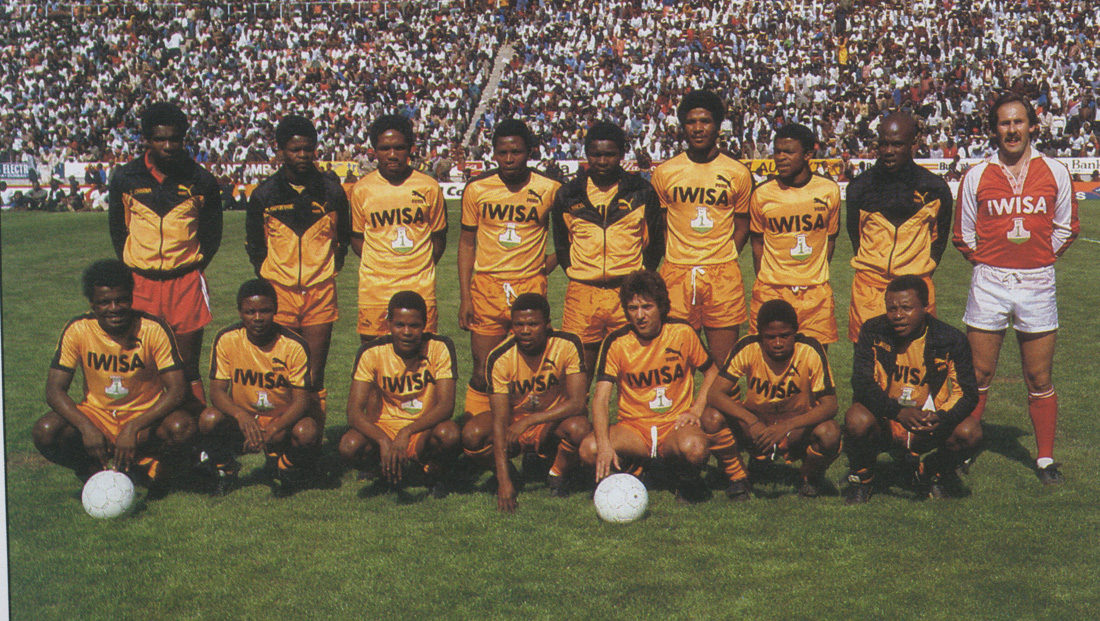 |
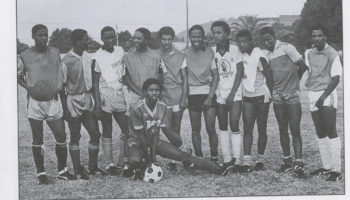 |

